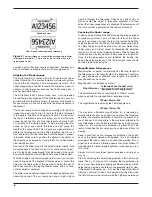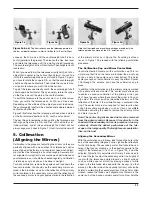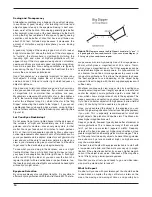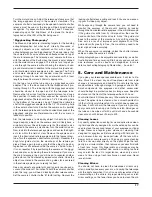
12
mirror holder stationary (be careful not to touch the surface of
the mirror), while turning the center screw with a Phillips head
screwdriver (See Figure 11). Turning the screw clockwise will
move the secondary mirror toward the front opening of the
optical tube, while turning the screw counter-clockwise will
move the secondary mirror toward the primary mirror.
Note: When making these adjustments, be careful not to
stress the spider vanes or they may bend.
When the secondary mirror is centered in the focuser draw-
tube, rotate the secondary mirror holder until the reflection of
the primary mirror is as centered in the secondary mirror as
possible. It may not be perfectly centered, but that is OK. Now
tighten the three small alignment screws equally to secure the
secondary mirror in that position.
If the entire primary mirror reflection is not visible in the sec-
ondary mirror, as in Figure 10c; you will need to adjust the tilt
of the secondary mirror. This is done by alternately loosening
one of the three alignment set screws while tightening the
other two, as depicted in Figure 12. The goal is to center the
primary mirror reflection in the secondary mirror, as in Figure
10d. Don’t worry that the reflection of the secondary mirror
(the smallest circle, with the collimation cap “dot” in the cen-
ter) is off-center. You will fix that in the next step.
Aligning the Primary Mirror
The final adjustment is made to the primary mirror. It will need
adjustment if, as in Figure 10d, the secondary mirror is cen-
tered under the focuser and the reflection of the primary mir-
ror is centered in the secondary mirror, but the small reflec-
tion of the secondary mirror (with the “dot” of the collimation
cap) is off-center.
The tilt of the primary mirror is adjusted with three spring-
loaded collimation thumbscrews on the back end of the opti-
cal tube (bottom of the primary mirror cell); these are the larg-
er thumbscrews. The other three smaller thumbscrews lock
the mirror’s position in place; these thumbscrews must be
loosened before any collimation adjustments can be made to
the primary mirror.
Figure 12:
Adjust the tilt of the secondary mirror by loosening or
tightening the three alignment set screws with a 2mm Allen wrench.
Figure 11:
To center the secondary mirror under the focuser, hold
the secondary mirror holder in place with one hand while adjusting
the center bolt with a Phillips screwdriver. Do not touch the mirror’s
surface. This adjustment will rarely need to be done.
Figure 10.
Collimating the optics. (a) When the mirrors are properly aligned, the view
down the focuser drawtube should look like this (b) With the collimation cap in place, if the
optics are out of alignment, the view might look something like this. (c) Here, the secondary
mirror is centered under the focuser, but it needs to be adjusted (tilted) so that the entire
primary mirror is visible. (d) The secondary mirror is correctly aligned, but the primary mirror
still needs adjustment. When the primary mirror is correctly aligned, the “dot” will be
centered, as in (e).
a.
b.
c.
d.
e.
Summary of Contents for AstroView 6 EQ 9827
Page 19: ...19 ...






































